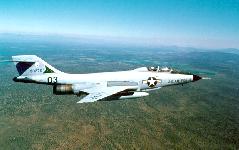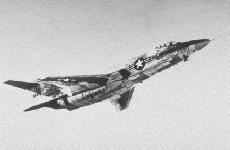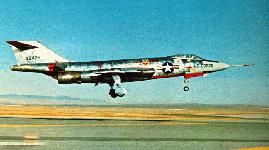







Produced by McDonnell Aircraft Co., the F-101 was the first USAF fighter capable of over 1,000 mph in level flight. It was produced in two configurations: air defense fighter (F-101B), and reconnaissance (RF-101A). The F-101 was originally designed as a long-range bomber escort and penetration fighter for the Strategic Air Command. However, with the development of high-speed, high-altitude jet bombers, escort fighters became unnecessary and the first Voodoos off the production line were assigned to the Tactical Air Command in 1957. The first F-101 made its initial flight on September 29, 1954. The F-101B first flew on March 27, 1957. Voodoo production continued until March 1961.
McDonnell Aircraft Corporation built almost 800 Voodoos, including 47 F-101Cs with wings strengthened for low-altitude tactical bombing. The version used most extensively was the two-seat F-101B interceptor which carried a pilot and a radar operator. In the RF-101A and RF-101C reconnaissance versions, the USAF had the world's first supersonic photo-reconnaissance aircraft. RF-101s were used extensively for low altitude photo coverage of missile sites during the 1962 Cuban Missile Crisis and during the late 1960s in Southeast Asia. F-101F aircraft were modified B models with only minor exterior differences.
Specifications | |
| Wing Span | 39 feet, 8 inches |
| Length | 67 feet, 5 inches |
| Height | 18 feet |
| Weight | 51,921 lbs. maximum |
| Armament | Two Air-2A Genie rockets and GAR-1D or GAR-2A guided missiles |
| Engines | |
| Cost | $1,819,000 |
| Maximum speed | 1,095 mph |
| Cruising speed | 545 mph |
| Range | 800 miles |
| Service Ceiling | 52,400 feet |



